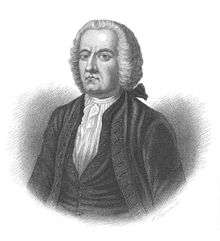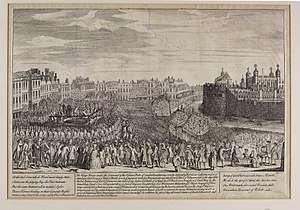Arthur Elphinstone, 6th Lord Balmerino
Arthur Elphinstone, 6th Lord Balmerino[lower-alpha 1] and 5th Lord Cupar (1688 – 18 August 1746) was a Scottish nobleman and Jacobite, or supporter of the claim of the exiled House of Stuart to the British throne.
Arthur Elphinstone, 6th Lord Balmerino | |
|---|---|
 Lord Balmerino; 19th century reproduction of a contemporary print | |
| Tenure | 1746 |
| Predecessor | James Elphinstone, 5th Lord Balmerino |
| Born | Arthur Elphinstone 1688 Leith |
| Died | 18 August 1746 (aged 57–58) Tower Hill, London |
| Cause of death | Execution |
| Buried | St Peter ad Vincula |
| Nationality | Scots |
| Residence | Balmerino House, Leith |
| Wars and battles | 1715 Jacobite Rising Sheriffmuir 1745 Jacobite Rising Prestonpans Falkirk Culloden |
| Spouse(s) | Margaret Chalmers |
| Parents | John, 4th Lord Balmerino Anne Ross |
As a military officer, he served in both the British and French armies, as well as taking part in Jacobite rebellions in 1715 and 1745, and spent nearly 20 years in exile on the Continent. He was pardoned some years after the first rebellion but following the failure of the latter at Culloden he was taken prisoner, charged with treason, and executed at Tower Hill. Historians of the 1745 rising often refer to him simply as Lord Balmerino, although he did not inherit the title until January 1746 and was for most of his life styled "the Hon. Arthur Elphinstone".
Life
Arthur Elphinstone was the son of John Elphinstone, 4th Lord Balmerino and 3rd Lord Cupar, and his second wife, Anne Ross or Rose, daughter of Arthur Rose, Archbishop of St Andrews. The family were descended from James (c.1553–1612), a younger son of Robert Elphinstone, 3rd Lord Elphinstone: he had been granted the lands of Balmerino Abbey in Fife by James VI and I, though by the 18th century a series of lawsuits had reduced the family's properties to the barony of Restalrig in South Leith. The Elphinstones were prominent members of the Episcopalian minority of the Scottish church: the burying ground of the ruined church at Restalrig on their estate was used by local Episcopalians throughout the 18th century.
Arthur had three half-brothers from his father's first marriage; Hugh, Master of Balmerino, who died in 1708 at the Siege of Lille, James (1675–1746), a lawyer and judge, and Alexander (d. 1733).[1][2][lower-alpha 2] He was not initially expected to inherit the family estate and embarked on a military career, being commissioned a captain in Lord Shannon's regiment in March 1714.[3]
As a north-eastern Episcopalian Protestant, Elphinstone has been described as epitomising the most "ideologically committed" Jacobite supporters.[4] Many Scottish Episcopalians were conservatives who believed the deposition of the Stuarts to have been a breach of natural order, and also opposed the 1707 Union of England and Scotland. During the Jacobite rising of 1715 he fought at the inconclusive Battle of Sheriffmuir on the government side but, reportedly finding this "against his conscience", deserted and joined the Jacobites.[5] The rising subsequently collapsed and he fled the country, possibly to Denmark, before joining the French army.
In 1733, Elphinstone's father obtained a pardon for him and he eventually returned to Scotland: about this time he married Margaret Chalmers or Chambers, daughter of a Captain Chalmers of Leith. His half-brother James succeeded to the title of Lord Balmerino on the death of their father in 1736.
Elphinstone was one of the first to join Charles Edward Stuart during his 1745 attempt to recover the British throne for the Stuarts. While his history of Jacobite activity was undoubtedly a factor, some contemporaries also suggested the family's poor financial standing meant he had little to lose. Alongside David Wemyss, Lord Elcho he was given command of a troop of Charles' "Life Guard"; unlike nearly all other senior Jacobites, he escaped any criticism in the post-rising memoirs by various participants.[6] John Daniel, a colleague in 1745, recorded that Elphinstone's "sole and predominant passion" was "hard drinking", but paid tribute to his loyalty, courage, and gift for languages, noting that "his memory for his years was wonderful".[6] He became the 6th Lord Balmerino in early 1746 following his half-brother James's death, but in April of the same year he was taken prisoner at the Battle of Culloden.
Balmerino was tried before Parliament, along with William Boyd, 4th Earl of Kilmarnock and George Mackenzie, 3rd Earl of Cromartie. Given his history and previous pardon, he represented himself and offered little in the way of a defence, joking that he only pleaded not guilty in order "that so many ladies might not be disappointed of their show".[7] He was found guilty, attainted and was beheaded on the same day as the Earl of Kilmarnock.[7]

Balmerino went to his execution unrepentant, stating "If I had a thousand lives, I would lay them all down in the same cause".[7] His insouciant attitude at the time of his trial and execution, joking with bystanders and insisting on taking the axe in his carriage so that Kilmarnock would not be bothered by it, was widely reported in the media of the time.[8] Horace Walpole, in a letter, described him as "the most natural brave old fellow I ever saw [...] at the bar he behaved like a soldier and a man: in the intervals of form, with carelessness and humour".[7] Balmerino's execution is sometimes reported to have taken three blows, though "the first certainly took away all sensation".[9][7] Like Kilmarnock he was buried in the Church of St Peter ad Vincula: reportedly, at his request, alongside William Murray, Marquess of Tullibardine.
Notes
- Also spelt "Balmerinoch", and once often pronounced "Bemirrney" by locals (The Antiquary, v.II, 1872, 280)
- Alexander Elphinstone is remembered for in 1724 playing the first ever golf match reported in a newspaper, against Captain John Porteous.
References
- Campbell, J. (1867) Balmerino and Its Abbey: A Parochial History, Paterson, p.391
- The New Peerage, v. II (1763), R. Davis, p.213
- Henshaw, V. (2014) Scotland and the British Army, 1700–1750: Defending the Union, A&C Black, p.106
- McLynn, F. (1985) The Jacobites, Routledge, p.88
- Henshaw, p.107
- MacKenzie Annand, A. "The Life Guards of Prince Charles Edward", Journal of the Society for Army Historical Research, Vol. 73, No. 293 (Spring 1995), 14–15
- The Gentleman's Magazine Published by F. Jefferies, volume 156 January–June 1834. p. 133 quoting the Letters of Horace Walpole to Sir Horace Mann.
- McKenzie, A. "Martyrs in Low Life? Dying “Game” in Augustan England", Journal of British Studies, Vol. 42, No. 2 (April 2003), 167–205
- Pittock, Murray G.H. (2004). "Oxford Dictionary of National Biography". Elphinstone, Arthur, sixth Lord Balmerino and fifth Lord Coupar (1688–1746). Oxford University Press. Retrieved 9 January 2014.